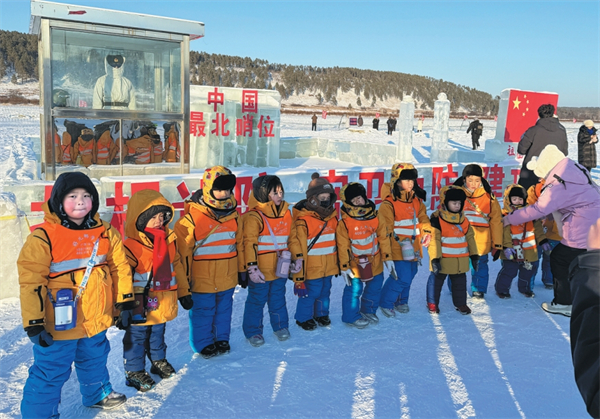Home>Biz updates
Allure of a more livable city
Updated : 2015-03-23
By Li Fusheng ( China Daily )
Local govt improves housing, roads and environment
Local authorities in Harbin are making the capital of Northeast China's Heilongjiang province a better place to visit and live.
Visitors say they sometimes feel like they are in Europe as they stroll along Central Street, while local residents say the air and water are cleaner and traffic less congested than before.
It is the result of the Harbin government's three-year campaign to improve the city's environment and make local people more satisfied with their lives.
The city has developed a long-standing, effective system that involves communities in programs to improve infrastructure, combat pollution and ease traffic.

Operational in 2010, 4-kilometer-long Songpu Bridge over the Songhua River is one of the major projects designed to greatly improve the city's transportation. [Photo provided to China Daily]
"It is a different city from what it was two years ago," said Xu Mingjun, a Harbin native who now lives in Canada.
"To my great surprise, every street and every corner is clean. Even old and poor buildings with peeling paint on the walls are clear of rubbish. These scenes make me proud of my home city."
Xu said the city now stands in stark contrast to what it was two years ago.
"At that time, the whole city was chaotic and dirty, and almost everything was out of order. I felt I wanted to flee my once-beloved Harbin," he said.
Improved traffic
And the improvements in daily life are even more apparent to full-time locals. An elderly man surnamed Li said crossing the road in front of his apartment used to be a problem.
"There was just one zebra crossing but a lot of people. And I could not hurry due to my age. Now it is much easier because an overpass has been built," said Li.
It is among eight overpasses built by the Harbin government this year to prevent pedestrian-car accidents and improve traffic flow.
In the past three years, local authorities also built or improved 111 roads and 27 bridges. The recently completed subway Line 1 has already transported more than 40 million passengers.
Projects to extend Line 1 and build Lines 2 and 3 will start soon, said local officials. "As Harbin's metro network gradually takes shape, residents will find it more convenient and easier to travel," said Zhang Wei, a senior manager at Harbin Metro.
Local authorities have also built 20 more car parks that altogether can accommodate 16,000 vehicles. It placed 30 more bus stops on the road network, and added 605 new-energy buses and another 2,000 taxis to the citywide fleet.
More renovations
Improvements have also been made to buildings. Local authorities have now renovated a combined 7.98 million square meters of old housing for 120,000 urban residents.
Several shantytowns, including the Yujintai community, have taken on a new look and it narrow lanes have been well paved.
"The lanes were pockmarked. Things got worse when it rained and my car's chassis would scrape the ground," said Zhu Yan, who has lived in Yujintai for decades.
The Harbin government also built or renovated 1,000 km of pipelines for water, electricity, heating and gas.
It has funded the transformation of old downtown buildings and made them more energy efficient.
"My building had a facelift last year. It now looks more beautiful and room temperatures in my apartment in winter grew by about 3 to 5 degrees Celsius," said a woman surnamed Zhu who lives near Hexing Road in the city.
Zhu's apartment is one of the 40,000 that have been renovated. More energy efficient after renovation, each year they use 5,800 few tons of coal, which in turn cuts carbon dioxide emissions by 14.3 tons.
The Harbin government also phased out 45,000 vehicles that do not meet emission standards and implemented 101 energy-saving and emission-reduction projects across the city.
It has planted trees covering more than 9,200 hectares and improved the sewage treatment rate to 85 percent across the city.
Those living in the countryside have also benefited from the campaign. Local authorities have started construction on 146 infrastructure projects in towns including Zhoujia and Shuangjing. It also built 41,200 houses for rural residents.

Harbin ramps up childcare services
A new comprehensive service center for childcare in Harbin is expected to be finished by the end of the year.
-
Talent policies drive enterprise development in Harbin
Harbin's "30 New Talent Policies" represents an iterative upgrade to the talent policy system, helping attract and retain talent to bolster economic and social development.
-
Official website of 2025 Asian Winter Games goes live
Harbin, the host city of the 9th Asian Winter Games, has announced that the official website for the 2025 event has recently gone live.
-
Harbin launches measures to facilitate more foreign trade
In the first three quarters of 2023, the total import and export value of Heilongjiang province's goods trade hit 218.22 billion yuan.





